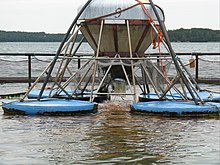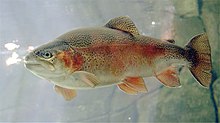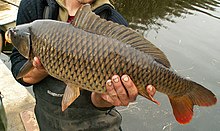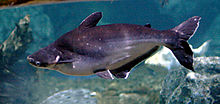Aquaculture


Aquaculture or aquafarming is the controlled rearing of aquatic organisms , i.e. organisms that live in water , in particular fish , mussels , crabs and algae . All organisms produced in aquaculture have in common that they are assigned to an owner. This is how aquaculture differs from traditional fishing in public waters. Aquaculture is becoming increasingly important , particularly because of overfishing .

The main worldwide activities in the field of aquaculture can be divided into three areas:
- Fish, mussel, shrimp farming and other (fattening) for the food industry, e.g. B. Oyster farming
- Seedling cultivation for fish farming, for species conservation or for stocking fishing waters
- Micro and macro algae cultivation for the chemical, pharmaceutical and food technology industries as well as the feed market
Procedure
Pond management
Classic and most common on mainland Europe are aquaculture systems in flowing or standing water under the open sky. Keeping them in ponds with standing water is typical and appropriate for fish that naturally prefer calm waters (e.g. carp , tench , pikeperch , pike ). In contrast, fish that are adapted to running waters with a high oxygen content and low temperatures (e.g. trout , grayling , arctic char , brook trout ) and char crossbreeds (Alsatian) are traditionally kept in elongated ponds with a flow of water (at least three times the water exchange per day). Since the 1970s, the attitude has spread in flow channels ( English raceways ). Flow channels are artificial streams with solid side walls and a laminar flow of water for optimal water exchange.
Aquaculture in natural waters
In Southeast Asia, especially in Vietnam on the lower reaches of the Mekong , rearing pangasius in floating cages for the local market is widespread. The comparatively undemanding fish is partly fed with by-products or waste products from agriculture and housekeeping, such as rice flour and vegetable scraps.
Aquaculture in the sea
This method is often based on net cages in the open sea or in bays (e.g. salmon in the Norwegian fjords). It is partly based on floating bodies made of wood and other things.
Closed circulatory systems
For several decades, attempts have been made to operate so-called closed circulation systems in order to become as independent as possible from environmental influences and high water consumption. However, many plants were closed again because of the costly water treatment and the associated high energy consumption as well as the lack of stability of the water quality achieved. However, this problem seems to be slowly being resolved. A culture system has now been developed that integrates the entire water treatment process in the tank, the integrated recirculating aquaculture system (IRAS) . This minimizes energy consumption and reduces costs. The required thermal energy is available unused in many places, for example through biogas plants . Such systems will make it possible in the future to produce fish products economically and ecologically at almost any place in the world. In September 2018, salmon was harvested for the first time in Switzerland from a recirculation system in Lostallo .
Aquaponics
Aquaponics ( suitcase word from aquaculture and hydroponics ) is a special form of closed aquaculture in circulatory systems and describes a mixed use system of fish keeping and plant production in an inorganic substrate . It is a closed nutrient cycle, which is managed in automated processes.
species
fishes
About 150 species of fish are aquacultured, the most important are listed here:
- Rainbow trout ( Oncorhynchus mykiss )
- Atlantic salmon ( Salmo salar )
- Pacific salmon ( Oncorhynchus ssp.)
- Common carp ( Cyprinus carpio )
- Grass carp ( Ctenopharyngodon idella )
- Silver carp ( Hypophthalmichthys molitrix )
- African catfish ( Clarias gariepinus )
- Eel ( Anguilla anguilla )
- Cichlids ( Tilapia and Oreochromis ssp.) 14 types of cichlids are suitable for aquaculture
- Milkfish ( Chanos chanos )
- Mullet ( Chelon labrosus )
- Striped perch (Cross: Morone saxatilis x chrysops )
- Sturgeon ( Acipenser ssp.)
- Pikeperch ( Lucioperca sandra )
- Pangasius ( Pangasianodon hypophthalmus )
- Sea bass ( Dicentrarchus labrax )
- Dorade ( Sparus aurata )
Rainbow trout
The fast-growing rainbow trout ( Oncorhynchus mykiss ) are of great importance in aquaculture and are mainly kept in oxygen-rich ponds in the low mountain ranges and southern Germany. Rainbow trout are suitable for pond management as well as for continuous, underwater, silo and channel systems with higher use of technology. From the American rainbow trout, introduced by Max von Born in the 19th century, different breeds of the individual breeders have emerged in Germany over the years, which differ in terms of spawning time, growth speed and physique. At the Research Institute for Biology of Agricultural Animals (FBN) in Dummerstorf, Mecklenburg, molecular biologists are investigating the genetic and immunological variability of trout breeds with regard to their reaction to abiogenic stress factors in the DIREFO project (Different Resistant Rainbow Trout). The aim was to isolate resilient trunks that are less susceptible to disease and can withstand greater temperature fluctuations in a stressful environment such as the holding basin of open systems with a high stocking density. The result of this breeding is the rainbow trout line "Born". Born trout tolerate higher salt contents in the water (brackish water), are less susceptible to stress and disease, even with high stocking densities, and are generally more fit than comparable rainbow trout breeds. The energy balance of the Born line is shifted in favor of stress management, but the meat shows hardly any qualitative losses.
Rainbow trout with a triploid gene set show the highest growth rates and quickly reach their final size. In Canada and Denmark in particular, triploid trout was breeding. Triploid trout produce a significantly higher carcass yield.
The currently largest rainbow trout weighing 24 kilograms was caught in 2009 from Lake Diefenbaker in Saskatchewan , Canada , and in 2007 a trout nearly as heavy as 21 kilograms. The triploid animals presumably came from transgenic animal material from a neighboring trout farm, which escaped into the reservoir.
Denmark was one of the pioneers of salmon and rainbow trout farming in aquaculture. In marine cages since 1950 and in aquaculture since the 1970s. Since 1987 there have been legal requirements that regulate the release of nutrient-enriched wastewater from trout farming into natural waters to prevent eutrophication . As early as 1914 there were 140 trout farms in Denmark that produced piece weights of 250 to 350 grams (commercially available "portion trout") for export . Another sales market is the sale of large trout weighing up to 15 kilograms in put & take fishing ponds. Thanks to technical progress, the ratio of the feed used to the fish produced has been sustainably optimized; now only 0.95 kilograms of dry feed are required for the production of one kilogram of trout meat (with approx. 75 percent water content).
carp
In Europe the carp is one of the most important food fish in aquaculture and pond farming. In 2007, 66,330 tons of carp with a market value of 140 million euros were produced. The main producers in Europe include the Czech Republic , Poland , Hungary and Germany . Carp fish are among the most important fish for aquaculture worldwide, with the main focus of production in Asia ( People's Republic of China , Myanmar and Indonesia ). Numerous local varieties and breeds have emerged as a result of the selection breeding that has been practiced for centuries.
In contrast to semi-extensive pond management, where carp look for a large part of their food in their natural environment, in aquaculture carp are fattened in basins from a certain size until they are ready for slaughter. Because the carp eats most of its food on the bottom, its meat has a muddy and undesirable aftertaste that it only loses after it has been kept in clear water for a certain period of time. In Germany, the demand for table carp is declining due to changed eating habits.
In 1971 Dr. Meske and his team from the Federal Research Center for Fisheries in Ahrensburg designed the year-round warm water maintenance for carp in circular economy and flow systems, which led to a much faster growth, sexual maturity and reaching maturity of this Central Asian and very heat-loving fish species.
With process heat from the Jänschwalde lignite power station near Cottbus , a constant water temperature of 23 ° C is achieved for keeping carp from Fischzucht Jänschwalde GmbH and Peitzer Edelfisch GmbH, which enables the fish to grow all year round.
Tilapia
The tilapia cichlids, which originate from the tropics and subtropics, are produced in large numbers in aquaculture worldwide due to their high reproductive rate ( mouthbrooders ), rapid growth, robustness against environmental influences and low susceptibility to disease. The three commercially used cichlid genera Tilapia , Sarotherodon and Oreochromis were previously combined in the genus Tilapia . Today they are differentiated based on their reproductive behavior: see table.
| genus | Reproductive behavior |
|---|---|
| Oreochromis | Nest builders and mouth brooders, only females breed |
| Tilapia | Nest builders and ground breeders |
| Sarotherodon | Nest builders and mouthbrooders, both sexes breed |
Tilapias are also known as " water chicken " because of their high water temperature requirements (20–30 ° C) . The optimum is 25 ° C. Tilapias are characterized by excellent feed conversion. Oreochromis niloticus, for example, is euryphag (omnivorous), can be fed with household and agricultural waste and, in addition to aquatic plants, even filters out larger algae from the water. The species Oreochromis niloticus, Oreochromis mossambicus and Oreochromis aureus are mainly bred in larger plants .
Sexually mature tilapia (after six months) multiply six to eight times a year, which leads to a build-up of large populations. It must be noted that breeding animals show strong territorial behavior and can fatally injure their fellows during this time.
The Nile cichlid ( Oreochromis niloticus ) is of great economic importance in 85 countries in Africa , Asia and America in extensive (pond management) and intensive keeping (aquaculture) . There are significant aquacultures with tilapia in the People's Republic of China , Indonesia , the Philippines , Thailand , Vietnam and Taiwan . For example, Taiwan exports tilapia for the Japanese sashimi market. In addition to carp and salmonids , tilapia cichlids are the third most popular fish in freshwater production. The United States imports 56,000 tons of tilapia fillets annually (mostly from Mexico but also from Honduras , Costa Rica and Ecuador ). The European market is served from Israel and African countries such as Zambia . In production technology, Israeli companies such as APT Aquaculture Production Technology Ltd. Market leader.
With appropriate feeding, tilapia reach an average weight of 500 grams after nine months. In intensive fattening conditions, stocking densities of 100 individuals per cubic meter can be used. The systems can be operated with different intensities, from very simple (simple extensive pond management with little control over water quality, minimal feeding and low yield) to highly complex with falling production costs and high fish yield / area used. Fish stocking more than 1.5 kilograms per cubic meter requires disease and pest control as well as artificial enrichment of the water with oxygen.
“To produce tilapia in a cost effective manner, production systems must be capable of maintaining proper levels of these water quality variables during periods of rapid fish growth. To provide for such growth, tilapia are fed high protein pelleted diets at rates ranging from 1.0% to 30% of their body weight per day depending upon their size and species. ”
Pangasius
The production of pangasius catfish is increasing rapidly worldwide due to its white and very low-fat meat, and pangasius fillet is also in high demand in Europe. The main producing country with a market share of 90 percent is currently Vietnam . One of the main customer countries in the European Union is Poland . Commercially used species are Pangasius hypophthalmus and Pangasius bocourti , the latter having a slightly higher fat content. In the 1990s, the French fisheries biologist Marc Legendre began genetically improving pangasius catfish in Vietnam. The production is relatively unproblematic due to the low oxygen requirement and robustness of these omnivorous fish. Rearing takes place in ponds, floating cages and net pens. The slaughter weight of 1.5 to 2 kilograms is reached after six months with appropriate feeding. In traditional Asian pond farming, pangasius is fed with plant waste; for fast agro-industrial fattening, pellets (often from rice processing ) with a protein content of 26 percent and a fat content of 5 percent have become popular. Feed made from fish meal and oil is also used. To improve sales opportunities in the relatively new European market, Vietnamese fish farmers have implemented quality management based on the quality tool hazard analysis and critical control points (HACCP) and ISO9001: 2000 standards.
Crayfish
- Crayfish
- Crabs and king crabs
- Prawns (king prawns, river prawns)
Shellfish
- mussels
- Oysters (see also oyster farming )
Major global aquaculture companies
- Blue Ridge Aquaculture, Inc., Martinsville, Virginia, USA (world's largest tilapia producer)
- Nutreco Aquaculture Holding NV, Amersfoort, Netherlands (world's largest aquaculture farmer)
- Mowi ASA , Oslo, Norway
- AKVA Group ASA, Bryne, Norway
- Taiwan Aquaponics Association , Taiwan
- Open Blue (operator of the largest mariculture farm )
development
Aquaculture and aquaculture technology is a rapidly growing market worldwide; In 2009, according to the FAO, 55 million tons of fish came from aquaculture, which was a little more than a third of the total of 145 million tons of fish caught. In 2003, more than 1.6 million tons of crustaceans were raised in shrimp farms . Their market value was nearly $ 9 billion.
Between 1990 and 2003 the average annual growth reached ten percent. China is particularly well represented in aquaculture , which in 2006 accounted for 70 percent of global production according to the official FAO statistics. The growth of aquaculture in general would be only five percent without the Chinese contribution.
The advantages of aquaculture over traditional fishing lie on the one hand in lower prices (the price of salmon from aquaculture has decreased by around 80% since the beginning of the 1980s) and in the continuous and predictable supply. For example, while the occurrence of wild salmon is subject to strong fluctuations, the yield from aquaculture is more consistent and easier to predict, which makes it easier for supermarkets to integrate the fish into their offerings.
Health consequences for the fish
The high stocking densities and stress-weakened immune systems associated with this form of intensive farming make the fish susceptible to various types of diseases, including fins injuries due to constant rubbing against conspecifics, cataracts and parasite infestation.
Since fish also have a sense of pain , animal rights organizations such as the Albert Schweitzer Foundation criticize the current situation for our fellow world and demand improvements in keeping conditions.
Ecological consequences
Problems arise from the over-fertilization of water bodies, especially in marine aquacultures, due to incomplete food, excretion of fish and dead fish. In addition, the fish kept in unnaturally large and dense groups and bred for maximum yields are more susceptible to disease than wild fish and therefore need antibiotics or other means against parasites, which also endanger the ecosystems of the environment and human health. Technological progress partially alleviates the consequences: excretions of Norwegian salmon were reduced between 1975 and 2003 from around 180 kilograms to 30 kilograms per ton of fish produced. The antibiotics used in 2003 corresponded to around 0.5 percent of the amount that was needed in 1990.
The spread of aquaculture has had negative consequences, particularly in countries with low ecological standards in Southeast Asia. For example, around 70 percent of the mangrove population in the Mekong Delta has been lost since 1975. A large part of these losses is credited to shrimp farming .
There is also a risk of fish breaking out and mixing with or displacing natural stocks. For example, in the 1990s, a total of around one million Atlantic salmon escaped cultures on the American west coast and established themselves there outside of their natural range. This disadvantage will probably be eliminated in the future by the use of indoor fish farming systems. Here a complete isolation from the surrounding ecosystem is guaranteed.
The advantage of aquaculture is that it counteracts overfishing of the oceans and represents a new source of food. However, this only applies to some of the aquacultures. Carnivorous fish such as salmon or trout require animal protein, which is often obtained from wild fish ( fish meal ). To raise one kilogram of fish, you need about four kilograms of food. Only herbivorous fish such as carp can actually relieve the oceans. In 2003, around 80 percent of the world's aquaculture stocks were herbivores or omnivores.
See also
- Organic aquaculture
- Stephan Ludwig Jacobi (1711–1784) inventor of artificial fish farming
- Hydroponics
- Norwegian Aquaculture Center
literature
- Colin Nash: The History of Aquaculture . Wiley-Blackwell, 2011, ISBN 0-8138-2163-0 .
- Thundathil V. Pillay: Aquaculture. Principles and Practices. Fishing News Books, Oxford 1990, ISBN 0-85238-168-9 .
Web links
- Link catalog on aquaculture at curlie.org (formerly DMOZ )
- Aquaculture info - information platform on aquaculture
- Freshwater Trout Aquaculture Dialogue (English; PDF; 290 kB)
- Website for Blue Ridge Aquaculture (English)
- Website of Nutreco, the international animal nutrition and fish feed company and (English)
- Website of Marine Harvest (English)
- Website of Aqua Group (English)
- Sena S. De Silva et al. a .: Tilapias as Alien Aquatics in Asia and the Pacific. A review. ( Memento of January 24, 2012 in the Internet Archive ) In: FAO Fisheries Technical Paper. No. 453, 2004.
- Meinolf Rohleder: Aquaculture in Westphalia
swell
- ^ Swiss television: program "Kassensturz": Pangasius cheap fish with aftertaste
- ↑ Agintec: Situation. AGINTEC GmbH, Homburg / Saar, accessed on July 17, 2011 .
- ↑ Simona Caminada: Swiss premiere: First salmon from Lostallo. In: srf.ch . September 21, 2018, accessed September 27, 2018 .
- ↑ Aquaponics - getting started. ( Memento from September 17, 2009 in the Internet Archive ) In: Aquaponics blog. April 25, 2009.
- ^ Cultured Aquatic Species Information Program. Chanos chanos. In: Food and Agriculture Organization of the United Nations. (English).
- ↑ Federal Agency for Agriculture and Food (Ed.): Preserving agrobiodiversity in Germany and using it sustainably - high-quality fish from aquaculture ( page no longer available , search in web archives ) Info: The link was automatically marked as defective. Please check the link according to the instructions and then remove this notice. (PDF, 180 kB).
- ↑ Leibniz Institute for Farm Animal Biology in Dummerstorf
- ^ Research Institute for the Biology of Farm Animals: Research / 209: Aquaculture - Rainbow trout in climatic stress (idw). In: Schattenblick. March 9, 2009.
- ↑ A. Müller-Belecke, Sabine Gebhardt u. a .: Comparison of the fattening performance and carcass composition of diploid and triploid portion trout (Oncorhynchus mykiss) under practical conditions. (PDF; 553 kB) In: Breeding Science. 78, No. 2, 2006, pp. 129-135.
- ↑ Brandon Keim: 48-Pound Trout: World Record or Genetic Cheat? In: Wired. September 15, 2009.
- ↑ Food and Agriculture Organization of the United Nations (Ed.): National Aquaculture Sector Overview Denmark. (English)
- ↑ carp. In: European Commission. Fishing.
- ^ C. Meske: Warm water fish farming. New aquaculture practices. In: The natural sciences. 58, No. 6, pp. 312-318, doi: 10.1007 / BF00624736 .
- ^ Website of the Peitzer Edelfisch
- ↑ Thomas Ramge: From carp and coal. In: brand eins , September 2002.
- ↑ Michael Klug: Carp and eels under cooling towers. In: Potsdam's latest news. January 13, 2009.
- ↑ a b Tilapia in the lexicon of aquaculture technology.
- ↑ a b c d Tilapia Farming. In: fishfarming.com. (English).
- ↑ Yonas Fessehaye: Natural mating in Nile tilapia (Oreochromis niloticus L.) Wageningen Institute of Animal Sciences, Wageningen 2006, ISBN 978-90-8504-540-3 (dissertation), p. 11.
- ^ Website of Aquaculture Production Technology Ltd. (English)
- ↑ a b Pangasius.at
- ↑ http: // ftp: //ftp.cordis.europa.eu/pub/inco/docs/aquaculture1/01cat960043catfish_en.pdf (link not available)
- ^ Website of Truong Thanh Agriculture Forestry Fishery Products Co., Ltd. (English)
- ^ Spiegel Online: "UN Fishery Report"
- ↑ a b c d e f The promise of a Blue Revolution. In: The Economist. 368, No. 8336, 2003, p. 19. (PDF)
- ↑ The state of knowledge about animal welfare and welfare in edible fish production. (PDF) Literature study on the status quo in practice and science. Research Institute for Organic Agriculture , October 2012, accessed December 8, 2015 .
- ↑ Factory farming - fish in aquaculture. Avoidability and demands. (No longer available online.) Albert Schweitzer Foundation for Our Environment, archived from the original on December 10, 2015 ; Retrieved December 8, 2015 .













